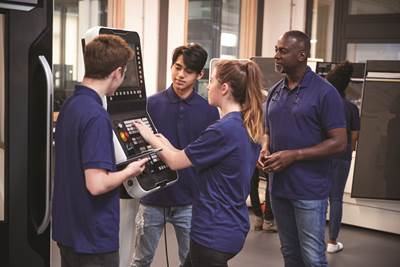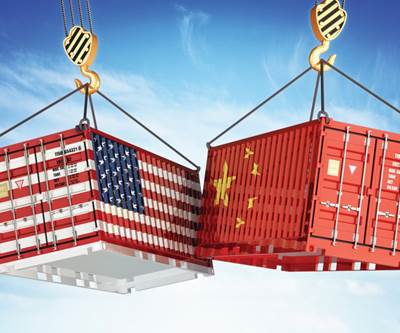Smart technology is all around us today, including smartphones, smart thermostats, smart stereo speakers and smart parking meters. From our appliances to our shared infrastructure, the systems and materials we interact with daily are only getting smarter.
But “smart” isn’t just a buzz word; it’s a legitimately big deal. Labeling something smart, in the broadest definition, means a product or system adapts to its user to make the experience of its use easier. A smart parking lot can broadcast how much capacity it has available and guide a motorist to an open space. A smart thermometer can cool your house by turning on the air conditioning on a hot night, 30 minutes before you arrive.
These examples are made possible by the burgeoning Internet of things (IoT), which is the extension of internet connectivity to everyday devices, and the advent of fifth-generation cellular network technology (better known as 5G) that makes data transfer almost instantaneous.
That hyperconnectivity and blazing speed are now leading to the rise of the smart factory.
By weaving together the chains of production instead of simply linking them, manufacturers will be able to create more responsive and specific products. What’s more, they’ll be able to do so reliably.
Smart Manufacturing
Smart manufacturing is not science fiction; there are plenty of steps along the production process manufacturers can streamline, and it only follows that the manufacturing sector is an obvious place for such technology to take hold. Nor is smart manufacturing simply automation by another name; not that that kind of improved productivity is a true threat to manufacturing employment anyway. Instead, it’s potentially the next big thing.
Think about it— by weaving together the chains of production instead of simply linking them, manufacturers will be able to create more responsive and specific products. What’s more, they’ll be able to do so reliably.
For example, consider the ability to integrate decisions made on a shop floor into product design in real time or being able to reroute inventory directly to customers to match changes in demand. This kind of flexibility will prove extraordinarily helpful to businesses, and it will make the manufacturing process exponentially more efficient.
In a nutshell, that explosion of interaction (IoT) and efficiency (5G) is a smart factory. It is in our near future, and American manufacturers are preparing for it, but this also includes preparing for the inherent risks.
Smart Risks
Some risks are obvious. For example, how do we make a wholly integrated IoT secure?
Cybersecurity has become a daily part of our increasingly online lives, and it’s no different for manufacturers. Businesses must constantly protect themselves against attempts at intellectual property theft, sabotage and even data corruption because of the exposure that our shared online space brings.
Other risks double as challenges, like how best to ensure this technology advent we’re witnessing can still be used by small- and mid-size manufacturing companies that don’t have internal R&D, or access to large amounts of capital. Their participation is important to maintain. Apple was famously founded in a garage, after all. So how should we guarantee this potential industrial revolution has a low barrier to entry requirement for a strong culture of ground-up innovation?
The answer to both of these problems is the same. You lay the ground rules for the rollout and implementation of this technology, and you set the parameters for its use. Some market forecasts predict $1 trillion in added value generated from smart manufacturing processes by 2025. If that’s the case, our government should establish the norms of behavior, so smart manufacturers can focus on meeting that economic potential.
Smart factories are coming, and they’re quietly, incredibly important. We should be preparing the way for them by thinking about the guardrails in which we want them to operate.
The United States should create a manufacturing policy so American manufacturers can thrive in its framework. And luckily, we’ve got a framework upon which to build. The Manufacturing USA program, a nationwide network of centers each focused on an emerging trend in production, has better connected domestic manufacturers with the fruits of government-funded R&D, and it should be drastically expanded.
However, there are equally useful legal moves that the government could make, for example championing rules on data governance in future trade deals and treating them as non-tariff barriers should other nations abuse them to create an artificial advantage. We should leverage the size of the American marketplace so that America’s smart manufacturing policy benefits American smart manufacturers.
Lastly, the U.S. should create such a policy because policy abhors a vacuum, and other manufacturing powerhouses (such as China or Germany at the lead of the European Union) have no intention of waiting for us to establish rules first. They realize a competitive edge is at stake, and we should take the hint and retain some of that edge for our own.
Smart factories are coming, and they’re quietly, incredibly important. We should be preparing the way for them by thinking about the guardrails in which we want them to operate.
About the Author
Scott N. Paul is president of the Alliance for American Manufacturing
Related Content
Making Quick and Easy Kaizen Work for Your Shop
Within each person is unlimited creative potential to improve shop operations.
Read MoreTackling a Mold Designer Shortage
Survey findings reveal a shortage of skilled mold designers and engineers in the moldmaking community, calling for intervention through educational programs and exploration of training alternatives while seeking input from those who have addressed the issue successfully.
Read MoreHow to Improve Your Current Efficiency Rate
An alternative approach to taking on more EDM-intensive work when technology and personnel investment is not an option.
Read MoreThe Trifecta of Competitive Toolmaking
Process, technology and people form the foundations of the business philosophy in place at Eifel Mold & Engineering.
Read MoreRead Next
Public Policies Needed to Maintain a Skilled Workforce
Expanded tuition assistance, increased apprenticeship programs and improved industry partnerships will keep the labor pool deep.
Read MoreThe Impact of International Trade Policy on Mold Manufacturing
The first step to impacting policy decisions is staying current with issues such as the U.S.-Mexico-Canada Agreement and U.S./China negotiations.
Read MoreHow to Use Strategic Planning Tools, Data to Manage the Human Side of Business
Q&A with Marion Wells, MMT EAB member and founder of Human Asset Management.
Read More















.png;maxWidth=300;quality=90)










